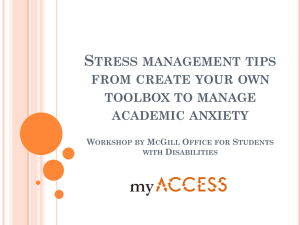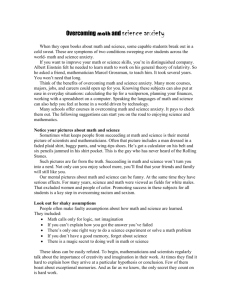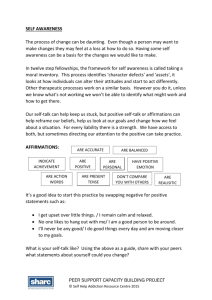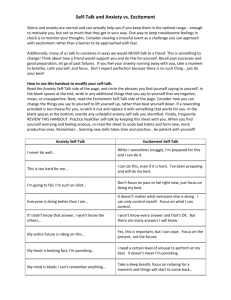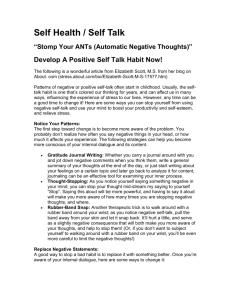How to Reduce Test Anxiety
advertisement
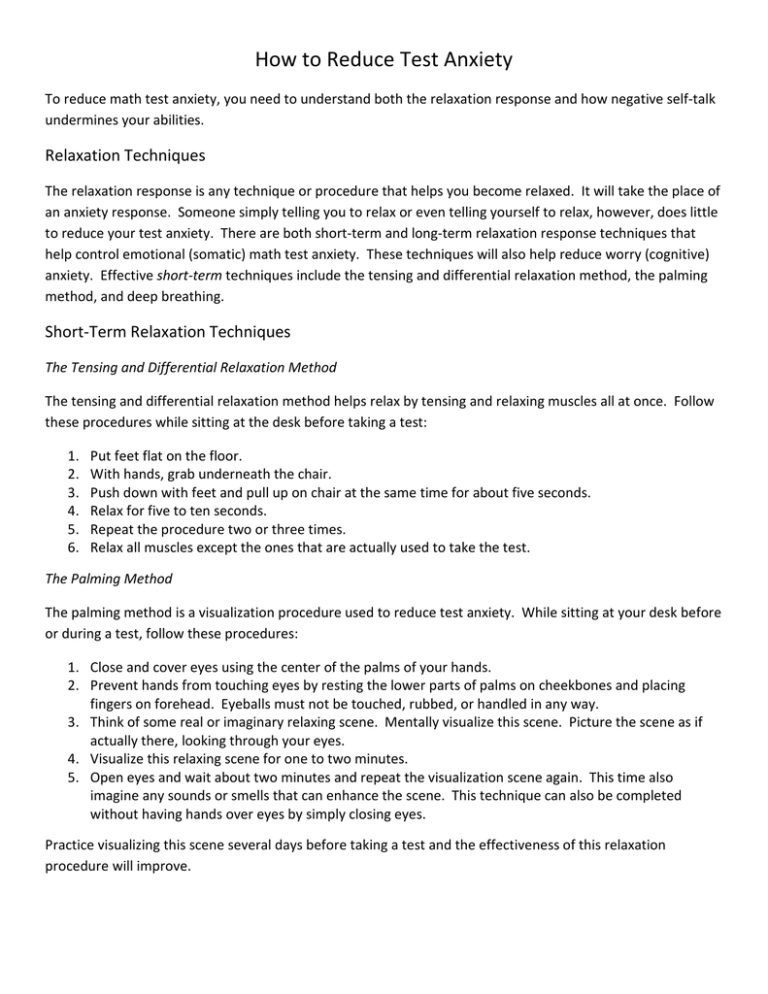
How to Reduce Test Anxiety To reduce math test anxiety, you need to understand both the relaxation response and how negative self-talk undermines your abilities. Relaxation Techniques The relaxation response is any technique or procedure that helps you become relaxed. It will take the place of an anxiety response. Someone simply telling you to relax or even telling yourself to relax, however, does little to reduce your test anxiety. There are both short-term and long-term relaxation response techniques that help control emotional (somatic) math test anxiety. These techniques will also help reduce worry (cognitive) anxiety. Effective short-term techniques include the tensing and differential relaxation method, the palming method, and deep breathing. Short-Term Relaxation Techniques The Tensing and Differential Relaxation Method The tensing and differential relaxation method helps relax by tensing and relaxing muscles all at once. Follow these procedures while sitting at the desk before taking a test: 1. 2. 3. 4. 5. 6. Put feet flat on the floor. With hands, grab underneath the chair. Push down with feet and pull up on chair at the same time for about five seconds. Relax for five to ten seconds. Repeat the procedure two or three times. Relax all muscles except the ones that are actually used to take the test. The Palming Method The palming method is a visualization procedure used to reduce test anxiety. While sitting at your desk before or during a test, follow these procedures: 1. Close and cover eyes using the center of the palms of your hands. 2. Prevent hands from touching eyes by resting the lower parts of palms on cheekbones and placing fingers on forehead. Eyeballs must not be touched, rubbed, or handled in any way. 3. Think of some real or imaginary relaxing scene. Mentally visualize this scene. Picture the scene as if actually there, looking through your eyes. 4. Visualize this relaxing scene for one to two minutes. 5. Open eyes and wait about two minutes and repeat the visualization scene again. This time also imagine any sounds or smells that can enhance the scene. This technique can also be completed without having hands over eyes by simply closing eyes. Practice visualizing this scene several days before taking a test and the effectiveness of this relaxation procedure will improve. Deep Breathing Deep breathing is another short-term relaxation technique that can help you relax. Proper breathing is a way to reduce stress and decrease test anxiety. When breathing properly, enough oxygen gets into your bloodstream to nourish your body and mind. A lack of oxygen in your blood contributes to an anxiety state that makes it more difficult to react to stress. Proper deep breathing can help you control your test anxiety. Deep breathing can replace the rapid, shallow breathing that sometimes accompanies test anxiety, or it can prevent test anxiety. Here are the steps to deep breathing: 1. 2. 3. 4. 5. 6. 7. Sit up straight in chair in a good posture position. Slowly inhale through your nose. As you inhale, first fill the lower section of your lungs and work way up to the upper part of the lungs. Hold breath for a few seconds. Exhale slowly through mouth. Wait a few seconds and repeat the cycle. Keep doing this exercise for four or five minutes. This should involve ten breathing cycles. Remember to take two normal breaths between each cycle. If you feel light-headed during this exercise, stop for thirty – forty-five seconds and start again. 8. Throughout entire exercise, make sure to keep breathing smoothly and in a regular rhythm without gulping air or suddenly exhaling. 9. As an extra way to improve relaxation, say “relax” or “be calm” to self as you exhale. This can start a conditioned response which can trigger relaxation when the words are repeated during anxious situations. Keep practicing, this conditioned response will strengthen. Practice is the key to success. Practice this breathing exercise for several weeks before using the technique during tests. If you do not practice this technique, then it will not work. After taking the first test keep doing the exercise several times a week to strengthen the relaxation response. Short-term relaxation techniques can be learned quickly but are not as successful as the long-term relaxation technique. Short-term techniques are intended to be used while learning the long-term technique. Long-Term Relaxation Techniques The cue-controlled relaxation response technique is the best long-term relaxation technique. Cuecontrolled relaxation means you can induce your own relaxation based on repeating certain cue words to yourself. In essence, you are taught to relax and then silently repeat cue words, such as “I am relaxed.” After enough practice, you can relax during math tests. The cue-controlled relaxation technique has worked with thousands of students. Negative Self-Talk According to cognitive psychologists, self-talk is what we say to ourselves as a response to an event or situation. These dialogues determine our feelings about that event or situation. Sometimes we say it so quickly and automatically that we do not even hear ourselves. We then think it is the situation that causes the feeling, but in reality it is our interactions or thoughts about the experience that are controlling our emotions. This sequence of events can be represented by this timeline: External Events (math test) Interpretation of Events and Self-Talk (how you feel about the test and what you are telling yourself) Feelings and Emotions (happy, glad, angry, mad, upset) In most cases this means that you are responsible for how and what you feel. You can have positive selftalk or negative self-talk about taking a math test. Yes, some students have positive self-talk about math tests and see if as a challenge and something to accomplish that makes them feel good, while others see it as an upsetting event that leads to anger and anxiety. In other words, you are what you tell yourself. Negative self-talk is a form of worry (cognitive) anxiety. This type of worrying can interfere with your test preparation and can keep you from concentrating on the test. Worrying can motivate you to study, but too much worrying may prevent you from studying at all. Negative self-talk is defined as the negative statements you tell yourself before and during tests. Negative self-talk causes students to lose confidence and to give up on tests. Further, it can give you an inappropriate excuse for failing math and cause you to give up on learning math. Students who have test anxiety are prone to negative self talk. Test anxiety can be generated or heightened by repeatedly making statements to yourself that usually begin with “what if.” For example, “What if I fail the test?” or “What if I fail this class again?” These “what if“ statements generate more anxiety which can cause students to feel sick. These statements tell them to be anxious. Some other aspects of self-talk are: • • • • • Self-talk can be in telegraphic form with short words or images. Self-talk can be illogical but at the time the person believes it. Negative self-talk can lead to avoidance like not taking the test or skipping classes. Negative self-talk can lead to depression and a feeling of helplessness. Negative self-talk is a bad habit which can be changed. There are different types of negative self-talk. If you have negative self-talk, then review the types below and see which one fits you best. You may use a combination of them: 1. The Critic is the person inside us who is always trying to put us down. It constantly judges behaviors and finds fault even if it is not there. It jumps on any mistake and exaggerates it to cause more anxiety. The Critic puts us down for mistakes on the test and blames us for not controlling the anxiety. The Critic reminds us of previous comments from real people who have criticized us. It compares us to other students who are doing better in the class. It loves to say, “That was a stupid mistake!” or “You are a total disappointment. You can’t pass this math class like everyone else can!” The Critic’s goal is to promote low self-esteem. 2. The Worrier is the person inside us who looks at the worst-case scenario. It wants to scare us with the ideas of disasters and complete failure. When it sees the first sign to anxiety, it “blows it out of proportion” to the extent that we will not remember anything and totally fail the test. The Worrier creates more anxiety than normal. The Worrier anticipates the worst, underestimates our ability, and sees us not only failing the test but “failing life.” The Worrier loves to ask “What if?” For example, “What if I fail the math test and don’t graduate?” or “What if I can’t control my anxiety and throw up in math class?” The goal of the Worrier is to cause more anxiety so we will quit. 3. The Victim is the person inside us who wants us to feel helpless or hopeless. It wants us to believe that no matter what we do, we will not be successful in math. The Victim does not blame other events (poor schooling) or people (bad teachers) for math failures. It blames us. It dooms us and puts us into a learned helpless mode, meaning that if we try to learn math, we will fail, or if we don’t try to learn math we will fail. So why try? The Victim likes to say, “I can’t learn math.” The goal of the Victim is to cause depression and make us not try. 4. The Perfectionist is similar to the Critic, but is the opposite of the Victim. It wants us to do the best we can and will guide us into doing better. It tells us that we are not studying enough for the math test and that a B is not good enough and that we must make an A. In fact, sometimes an A is not good enough unless it is a 100%. So, if we make a B on the test the Perfectionist says, “A or B is just like making an F.” The Perfectionist is the hard-driving part of us that wants the best but cannot stand mistakes or poor grades. It can drive us to mental and physical exhaustion to make that perfect grade. It is not interested in self-worth, just perfect grades. Students driven by the Perfectionist often drop a math course because they only have a B average. The Perfectionist loves to repeat, “I should have. . .” or “I must. . .” The goal of the Perfectionist is to cause chronic anxiety that leads to burnout. Review these types of personalities to see which one may fit best. We may have a little of each one in us, but what is the dominant one for you in math? Now we can look at how to stop these negative thoughts. Managing Negative Self-Talk Students need to change their negative self-talk to positive self-talk without making unrealistic statements. Positive self-statements can improve your studying and test preparation. During test, positive self-talk can build confidence and decrease your test anxiety. These positive statements can help reduce your test anxiety and improve your grades. Before the test, make up some positive statements to tell yourself. There are several ways to counter and control negative self-talk. Students can replace the negative self-talk with positive statements and questions that make them think in a realistic way about the situation. Another way is to develop thought stopping techniques to reduce or eliminate the negative thoughts. Try each way or a combination to see what works best for you. Countering self-talk involves writing down and practicing positive statements that can replace negative statements. Students can develop their own positive statements. Some rules for writing positive statements are: 1. Use the first person present tense, for example, “I can control my anxiety and relax myself.” 2. Do not use negatives in the statement. For example, do not say, “I am not going to have anxiety.” Instead say, “I will be calm during the test.” 3. Have a positive and realistic belief in the statement. For example say, “I am going to pass this test,“ instead of saying, “ I am going to make an A on this test” when you have not made and A on any of the tests. The statements used to counter the negative thoughts can be based on the type of negative self-talk. The Critic who puts down by saying, “Your test anxiety is going to cause you to fail the test” can be countered with, “I have test anxiety, but I am learning to control it.” The Worrier who says, “What if I fail the test” can be countered with “So what? I will do better on the next test.” The Victim who thinks things are hopeless and says, “I will never be able to pass math” can be countered with, “I have studied differently for this test, and I can pass the math course.” The Perfectionist who says, “I need to make an A on the test or I will drop out of school” can be countered with, “I do not need to make an A to please anyone. All I need is to pass the math course to get the career I want.” Thought-Stopping Techniques Some students have difficulty stopping their negative self-talk. These students cannot just tell themselves to eliminate those thoughts. These students need to use a thought-stopping technique to overcome their worry and become relaxed. Thought stopping involves focusing on the unwanted thoughts and, after a few seconds, suddenly stopping those thoughts by emptying your mind. Using the command “Stop!” or a loud noise like clapping your hands can effectively interrupt the negative self-talk. In a homework situation, you may be able to use a loud noise to stop your thoughts, but do not use it during a test. To stop your thoughts in the classroom or during a test, silently shout to yourself “Stop!” or “Stop thinking about that.” After your silent shout, either relax yourself or repeat one of your positive self-talk statements. You may have to shout to yourself several times during a test or while doing homework to control negative self-talk. After every shout, use a different relaxation technique/scene or positive self-talk statement. Thought stopping works because it interrupts the worry response before it can cause high negative emotions. During that interruption, you can replace the negative self-talk with positive statements or relaxation. However, students with high worry anxiety should practice this technique three days to one week before taking a test. Contact your counselor if you have additional questions about the thought-stopping techniques.
